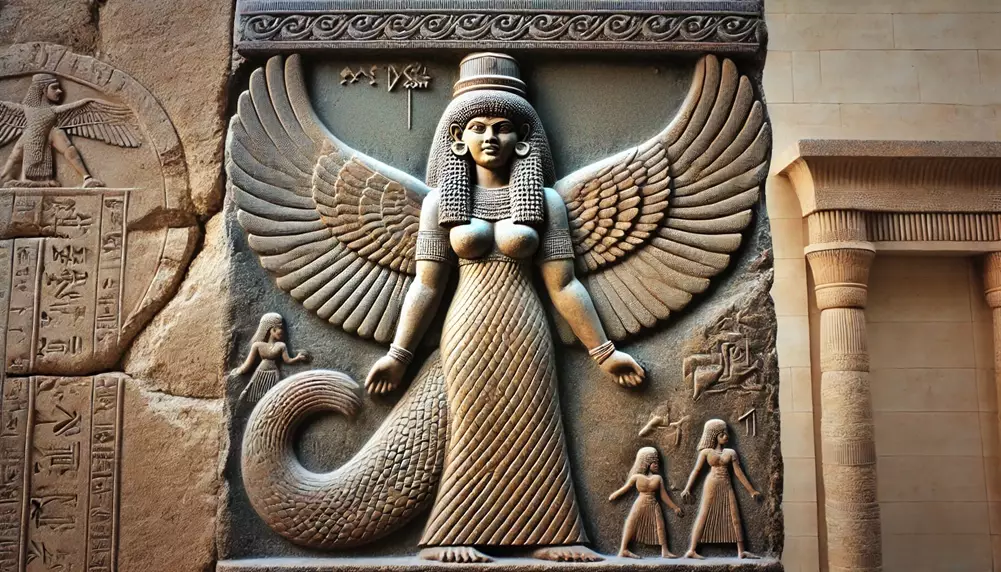Lilith: The Dark Mother and Enigmatic Spirit
Lilith, one of the most complex and debated figures in mythology, is known as a demoness, a seductress, a night spirit, and an icon of feminine defiance. Emerging from ancient Mesopotamian myths, she has traversed cultures and centuries, representing both fear and empowerment.
First appearing in Sumerian and Babylonian lore, Lilith evolved into a central figure in Jewish mysticism, described as the first wife of Adam who fled the Garden of Eden rather than submit to his authority. In medieval folklore, Lilith became a night demon, blamed for infant deaths and seduction of men.
Over time, her character has come to symbolize rebellion, freedom, and the untamed aspects of the feminine. Today, Lilith continues to influence literature, art, and feminist movements, embodying themes of independence, sexuality, and resistance against patriarchal constraints.
History/Origin
Lilith’s earliest known roots trace back to ancient Mesopotamian mythology, where she was associated with wind and storms. She appears in Sumerian texts as “Lillitu,” which is often translated as “of the night.” This early association with nocturnal forces would define much of her mythological character. One of her earliest references can be found in the Epic of Gilgamesh, where she is linked to the Huluppu tree, a sacred tree inhabited by three spirits: Lilith, a serpent, and a bird. This tale presents Lilith as a figure dwelling in dark and sacred places, foreshadowing her later association with the occult and the supernatural.
Lilith is also mentioned in ancient Babylonian incantations, where she is invoked as a malevolent spirit to be exorcized. The Babylonian Talmud, a key text of Jewish law and lore compiled between 200 and 500 CE, also mentions her, describing her as a female demon who preys on sleeping men and causes nocturnal emissions. Here, Lilith is portrayed as a succubus-like figure, preying on human desires.
A major shift in Lilith’s myth occurs in the Alphabet of Ben Sira, a Jewish text dated between the 8th and 10th centuries. This text portrays Lilith as Adam’s first wife, made from the same earth as he was. However, Lilith demands equality, refusing to submit to Adam’s authority during intercourse. According to the text:
“Why should I lie beneath you? I was also made from dust, and I am your equal.”
When Adam refuses her demand for equality, Lilith utters the sacred name of God and escapes Eden. In response, God sends three angels—Sanvi, Sansanvi, and Semangelaf—to bring her back. They find her by the Red Sea, where she has begun consorting with demons and bearing children. Lilith refuses to return, and the angels curse her, declaring that 100 of her demon children will die each day. This story marked Lilith’s transformation from a spirit associated with wind and storms into a figure of defiance, embodying both sexual freedom and maternal loss.
Name Meaning
The name “Lilith” is widely believed to derive from the Sumerian word lilitu, which can mean “of the night” or “wind.” This name likely reflected her early associations with the natural elements and nocturnal forces. In Hebrew, Lilith’s name is often translated as “night monster” or “night hag,” which aligns with her role in Jewish folklore as a bringer of nightmares and a spirit who prowls during the night. Throughout different cultures, Lilith’s name often carries connotations of the unknown and the forbidden, reflecting her dual nature as both a figure of dread and fascination.
The Hebrew word Lailah, meaning night, may have also contributed to Lilith’s name, underscoring her connection to the darkness and mysteries of the night. This etymology reflects Lilith’s role as a liminal being, residing on the boundaries between day and night, order and chaos.
Background Story
The myth of Lilith as Adam’s first wife who defies him is central to her legend. In the Alphabet of Ben Sira, Lilith’s refusal to submit to Adam is a radical act of defiance, one that results in her banishment from Eden. This myth portrays Lilith as a figure who chooses exile over subservience, marking her as a symbol of autonomy and resistance. After leaving Eden, Lilith is said to have taken refuge near the Red Sea, where she becomes the mother of demons. According to this narrative, Lilith is condemned to lose 100 of her children daily, fueling her anger towards humanity.

Beyond the Garden of Eden story, Lilith appears in various legends as a succubus who seduces men and causes them to have nocturnal emissions. These myths are often tied to medieval folklore, where Lilith is blamed for the deaths of infants and the seduction of young men. In these stories, Lilith becomes a scapegoat for unexplained deaths and phenomena, embodying the dangers of unchecked female sexuality.
Similar Beings
Lilith’s myth shares similarities with other female demon figures across cultures. For instance, the Mesopotamian Lamastu is another night demon who preys on infants, while the Greek Lamia, a demon who devours children, bears resemblances to Lilith’s malevolent aspects. In Slavic mythology, creatures like the Rusalka, female water spirits who seduce and drown men, also echo Lilith’s role as a dangerous seductress. These parallels highlight how various cultures have embodied their fears and desires in similar archetypes.
Cultural Impact
Lilith’s influence on Jewish culture is profound, particularly as a figure who must be warded off to protect mothers and children. Amulets bearing the names of the three angels sent to retrieve Lilith—Sanvi, Sansanvi, and Semangelaf—are found in Jewish tradition, used to protect against Lilith’s supposed malice. These amulets often include inscriptions from the Talmud and other Jewish texts to invoke divine protection. In Jewish magical traditions, Lilith is depicted as a spirit to be controlled or repelled through the power of holy words and symbols.
The myth of Lilith also entered Christian folklore during the medieval period. In European witch trials, women accused of witchcraft were sometimes likened to Lilith, seen as agents of the Devil who seduced men and bore demonic offspring. In Renaissance art, Lilith is often portrayed as a beautiful but dangerous woman, embodying the archetype of the femme fatale. Artists like Michelangelo included Lilith in his depiction of the Garden of Eden on the Sistine Chapel ceiling, showing her coiled around the Tree of Knowledge.

Lilith also appears in various Middle Eastern and North African traditions. For instance, in Islamic lore, Lilith is sometimes associated with Al-Qareen, a demon who seduces men and causes harm to newborns. This connection underscores her role as a universal symbol of danger and temptation.
Religion/Ritual
Lilith’s role in religious rituals is particularly significant in Jewish tradition, where she is both feared and respected. To ward off Lilith, mothers would place protective amulets on their children, inscribed with the names of the three angels. These rituals reflect an attempt to control the uncontrollable, channeling divine power to keep Lilith at bay. In some practices, a circle of salt or flour is placed around the cradle, symbolizing a boundary that Lilith cannot cross.
Kabbalistic texts also describe Lilith as the queen of demons, consort of Samael, the Angel of Death. In these texts, Lilith represents the dark, feminine aspect of the divine, a counterpart to the Shekhinah, the feminine presence of God. In some Kabbalistic rituals, Lilith is invoked as a powerful spirit, with prayers and incantations used to control or appease her.
Scientific or Rational Explanations
Historians and psychologists have explored Lilith’s myth as a reflection of societal anxieties about women’s sexuality and independence. Some scholars argue that Lilith’s demonization reflects male fears of female autonomy. Her association with infant mortality and seduction may stem from attempts to rationalize the mysteries of birth and death. Lilith’s role as a night demon who causes sleep disturbances and seduces men could also be seen as an explanation for sleep paralysis or nocturnal emissions, both of which were poorly understood in ancient times.
Anthropologists also suggest that Lilith represents humanity’s need to personify and control natural forces. In this view, Lilith embodies the unpredictability of the night, the dangers of childbirth, and the fears surrounding death. These interpretations highlight how myth can serve as a lens for understanding complex emotions and experiences.
In Modern Culture
Lilith’s resurgence as a feminist icon has redefined her image in the modern era. In literature, she appears in Dante Gabriel Rossetti’s poem “Lilith,” where he describes her as the “witch he loved,” casting her as a seductive and dangerous figure. John Milton’s Paradise Lost also references Lilith as part of Satan’s entourage, a symbol of rebellion and unbridled passion. More recently, authors like Neil Gaiman and Anne Rice have incorporated Lilith into their works, using her as a symbol of power and independence.

In contemporary music, Lilith is often referenced as a symbol of feminine power. The 1990s music festival “Lilith Fair,” founded by Sarah McLachlan, celebrated female artists and was named in her honor as a reclamation of the demoness’s independence and strength. Musicians like Halsey and Lana Del Rey reference Lilith in their songs, evoking her as a muse for themes of defiance and autonomy.
Television and film have also embraced Lilith’s dark allure. In the series Supernatural, Lilith is portrayed as a powerful demon who serves as one of the show’s main antagonists. Similarly, in the video game series Diablo, she is depicted as the mother of demons, underscoring her association with the infernal and the forbidden. Lilith’s appearances in these mediums reflect her transformation into a complex character who embodies both fear and fascination.
In modern feminist circles, Lilith has been reimagined as a figure of empowerment. She is often cited as a symbol of the “dark feminine,” representing aspects of femininity that have been historically repressed or demonized. This reclamation of Lilith speaks to a broader cultural shift towards embracing and integrating aspects of identity that have been marginalized.




